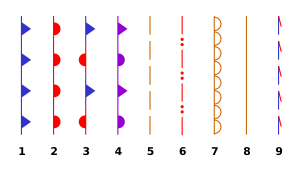Weather front facts for kids
A weather front is like a meeting point where two big groups of air, called air masses, come together. These air masses have different qualities, like how warm or cold they are, or how much moisture they hold. When they meet, they don't mix easily, and this often causes big changes in the weather.
Weather experts show fronts on weather maps using different colored lines and symbols. The air on one side of a front is usually different in temperature and humidity (how much water vapor is in the air) compared to the air on the other side.
Contents
What is a Weather Front?
A weather front is a boundary between two air masses that have different densities. Think of it like two different liquids that don't mix well, like oil and water. Air masses with different temperatures and humidity levels also have different densities.
When these air masses meet, the denser (often colder) air tends to push under the less dense (often warmer) air. This movement causes the air to rise, which can lead to clouds, rain, or even storms. Weather fronts are a main reason we experience significant weather changes.
Types of Weather Fronts
There are several types of weather fronts, each bringing different kinds of weather. The most common ones are cold fronts and warm fronts.
Cold Fronts
A cold front happens when a mass of colder, denser air moves into an area of warmer air. The cold air acts like a wedge, lifting the warm air quickly. This fast lifting of warm, moist air can create tall clouds and often leads to:
- Thunderstorms: Narrow bands of thunderstorms are common along cold fronts.
- Severe weather: Sometimes, cold fronts can bring strong winds, heavy rain, and even tornadoes.
- Squall lines: These are lines of strong thunderstorms that can form ahead of a cold front.
- Dry lines: These are similar to fronts but separate moist air from dry air, also causing storms.
After a cold front passes, the weather usually clears up quickly. The air becomes cooler and drier, and the winds often shift direction.
Warm Fronts
A warm front occurs when a mass of warmer, less dense air moves over an area of colder air. The warm air gently slides up and over the cooler air. This slower, more gradual lifting of air often creates wide areas of clouds and brings:
- Layered precipitation: This can include long periods of light rain, drizzle, or snow.
- Fog: As the warm, moist air moves over cooler ground, it can lead to widespread fog.
The weather after a warm front passes usually becomes warmer and more humid.
Other Fronts
- Stationary Fronts: Sometimes, two air masses meet but neither is strong enough to push the other away. This creates a stationary front, which can bring cloudy, wet weather that lasts for days.
- Occluded Fronts: These are more complex and happen when a cold front catches up to a warm front. They can bring a mix of weather, from rain to snow.
Images for kids
-
Different air masses that affect North America and other continents are often separated by frontal boundaries. For example, the Arctic front separates Arctic from Polar air, while the Polar front separates Polar air from warm air. (cA is continental arctic; cP is continental polar; mP is maritime polar; cT is continental tropic; and mT is maritime tropic.)
See also
 In Spanish: Frente (meteorología) para niños
In Spanish: Frente (meteorología) para niños





